Unemployment in Australia: Effects on the Economy and Government Policies
VerifiedAdded on 2023/06/08
|15
|3581
|422
AI Summary
This paper discusses the issue of unemployment in Australia in the last ten years and its effects on the economy. It examines the government policies towards reducing unemployment. The paper also highlights the effects of unemployment on the Australian economy and the various policies that can be used to reduce the rate of unemployment.
Contribute Materials
Your contribution can guide someone’s learning journey. Share your
documents today.
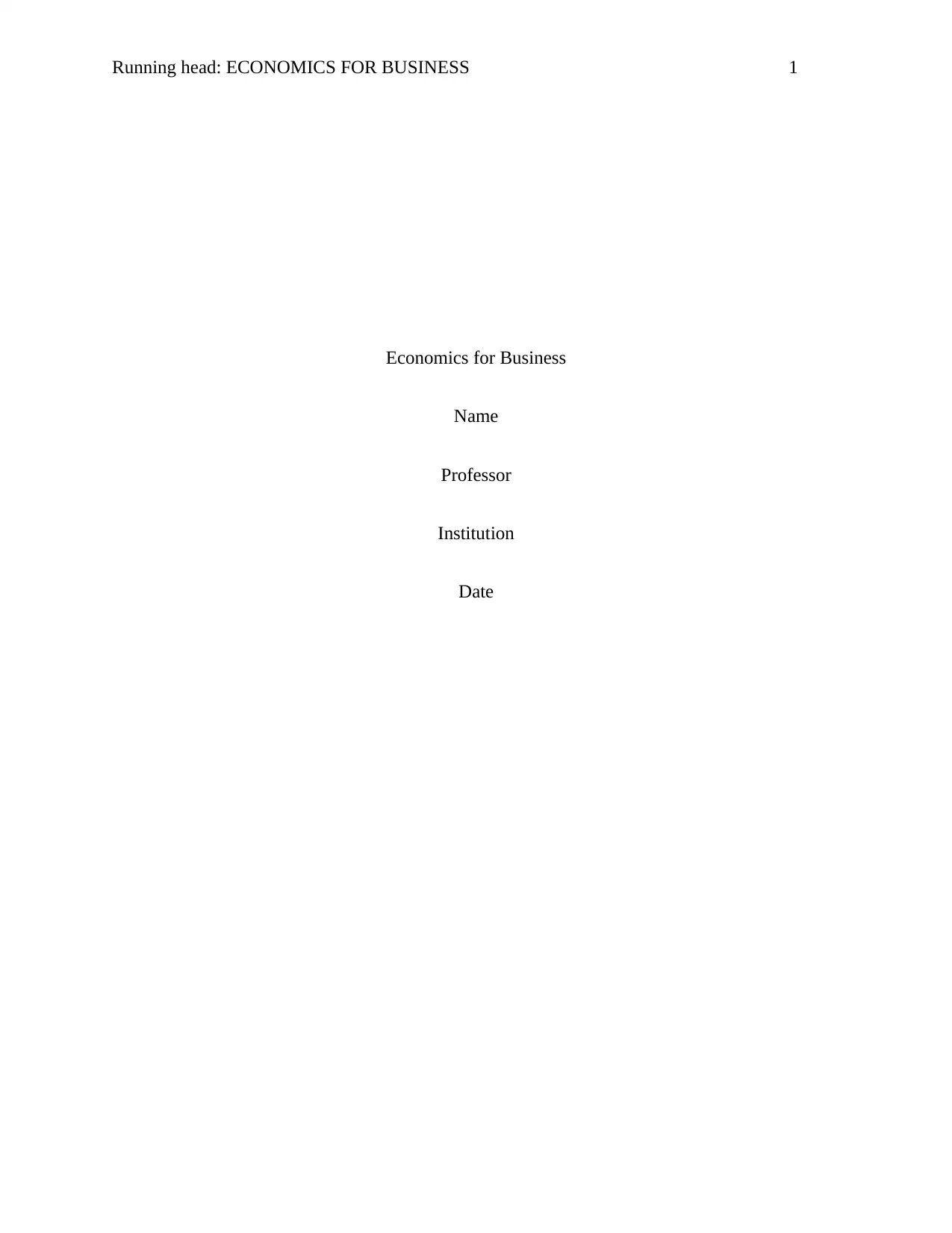
Running head: ECONOMICS FOR BUSINESS 1
Economics for Business
Name
Professor
Institution
Date
Economics for Business
Name
Professor
Institution
Date
Secure Best Marks with AI Grader
Need help grading? Try our AI Grader for instant feedback on your assignments.
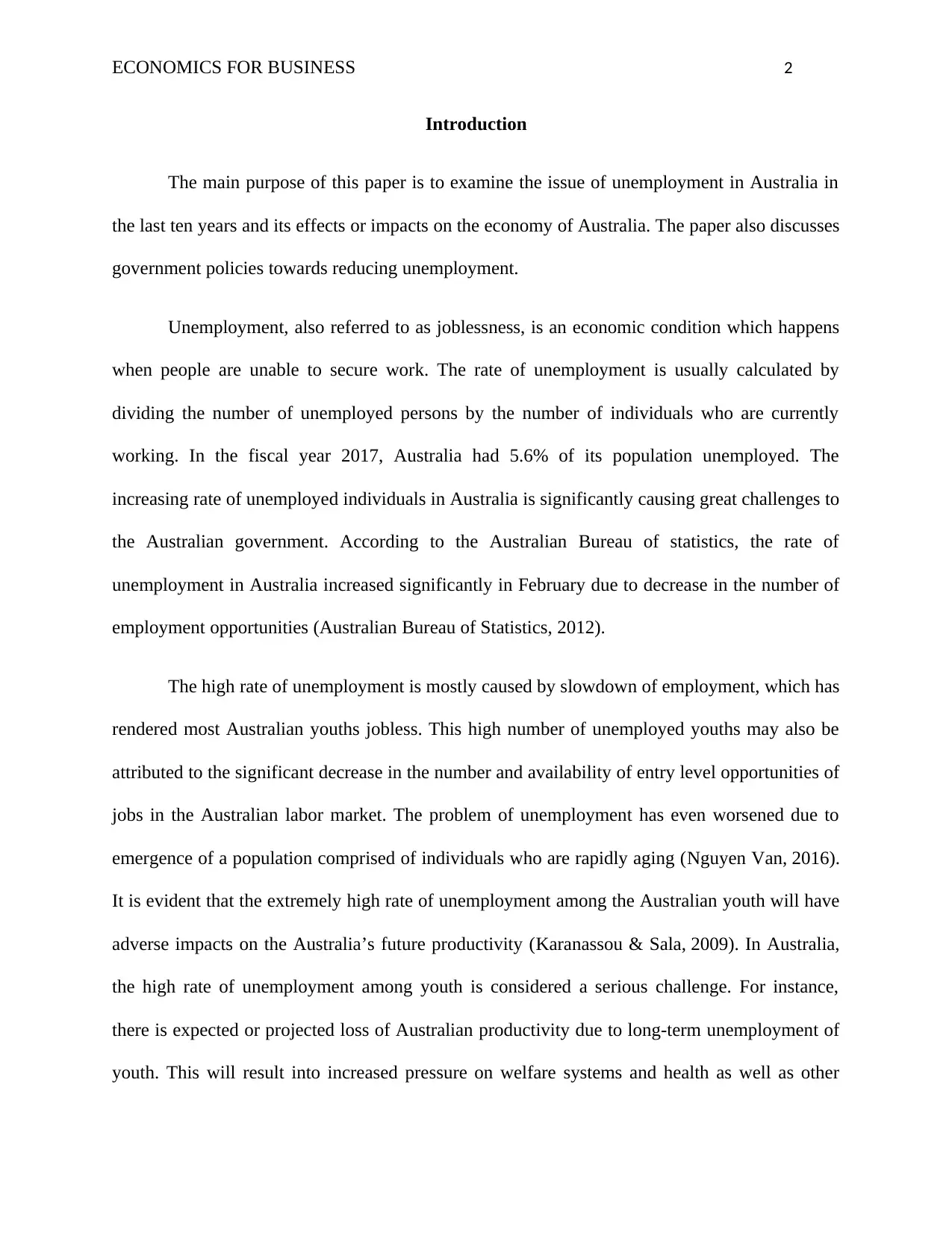
ECONOMICS FOR BUSINESS 2
Introduction
The main purpose of this paper is to examine the issue of unemployment in Australia in
the last ten years and its effects or impacts on the economy of Australia. The paper also discusses
government policies towards reducing unemployment.
Unemployment, also referred to as joblessness, is an economic condition which happens
when people are unable to secure work. The rate of unemployment is usually calculated by
dividing the number of unemployed persons by the number of individuals who are currently
working. In the fiscal year 2017, Australia had 5.6% of its population unemployed. The
increasing rate of unemployed individuals in Australia is significantly causing great challenges to
the Australian government. According to the Australian Bureau of statistics, the rate of
unemployment in Australia increased significantly in February due to decrease in the number of
employment opportunities (Australian Bureau of Statistics, 2012).
The high rate of unemployment is mostly caused by slowdown of employment, which has
rendered most Australian youths jobless. This high number of unemployed youths may also be
attributed to the significant decrease in the number and availability of entry level opportunities of
jobs in the Australian labor market. The problem of unemployment has even worsened due to
emergence of a population comprised of individuals who are rapidly aging (Nguyen Van, 2016).
It is evident that the extremely high rate of unemployment among the Australian youth will have
adverse impacts on the Australia’s future productivity (Karanassou & Sala, 2009). In Australia,
the high rate of unemployment among youth is considered a serious challenge. For instance,
there is expected or projected loss of Australian productivity due to long-term unemployment of
youth. This will result into increased pressure on welfare systems and health as well as other
Introduction
The main purpose of this paper is to examine the issue of unemployment in Australia in
the last ten years and its effects or impacts on the economy of Australia. The paper also discusses
government policies towards reducing unemployment.
Unemployment, also referred to as joblessness, is an economic condition which happens
when people are unable to secure work. The rate of unemployment is usually calculated by
dividing the number of unemployed persons by the number of individuals who are currently
working. In the fiscal year 2017, Australia had 5.6% of its population unemployed. The
increasing rate of unemployed individuals in Australia is significantly causing great challenges to
the Australian government. According to the Australian Bureau of statistics, the rate of
unemployment in Australia increased significantly in February due to decrease in the number of
employment opportunities (Australian Bureau of Statistics, 2012).
The high rate of unemployment is mostly caused by slowdown of employment, which has
rendered most Australian youths jobless. This high number of unemployed youths may also be
attributed to the significant decrease in the number and availability of entry level opportunities of
jobs in the Australian labor market. The problem of unemployment has even worsened due to
emergence of a population comprised of individuals who are rapidly aging (Nguyen Van, 2016).
It is evident that the extremely high rate of unemployment among the Australian youth will have
adverse impacts on the Australia’s future productivity (Karanassou & Sala, 2009). In Australia,
the high rate of unemployment among youth is considered a serious challenge. For instance,
there is expected or projected loss of Australian productivity due to long-term unemployment of
youth. This will result into increased pressure on welfare systems and health as well as other
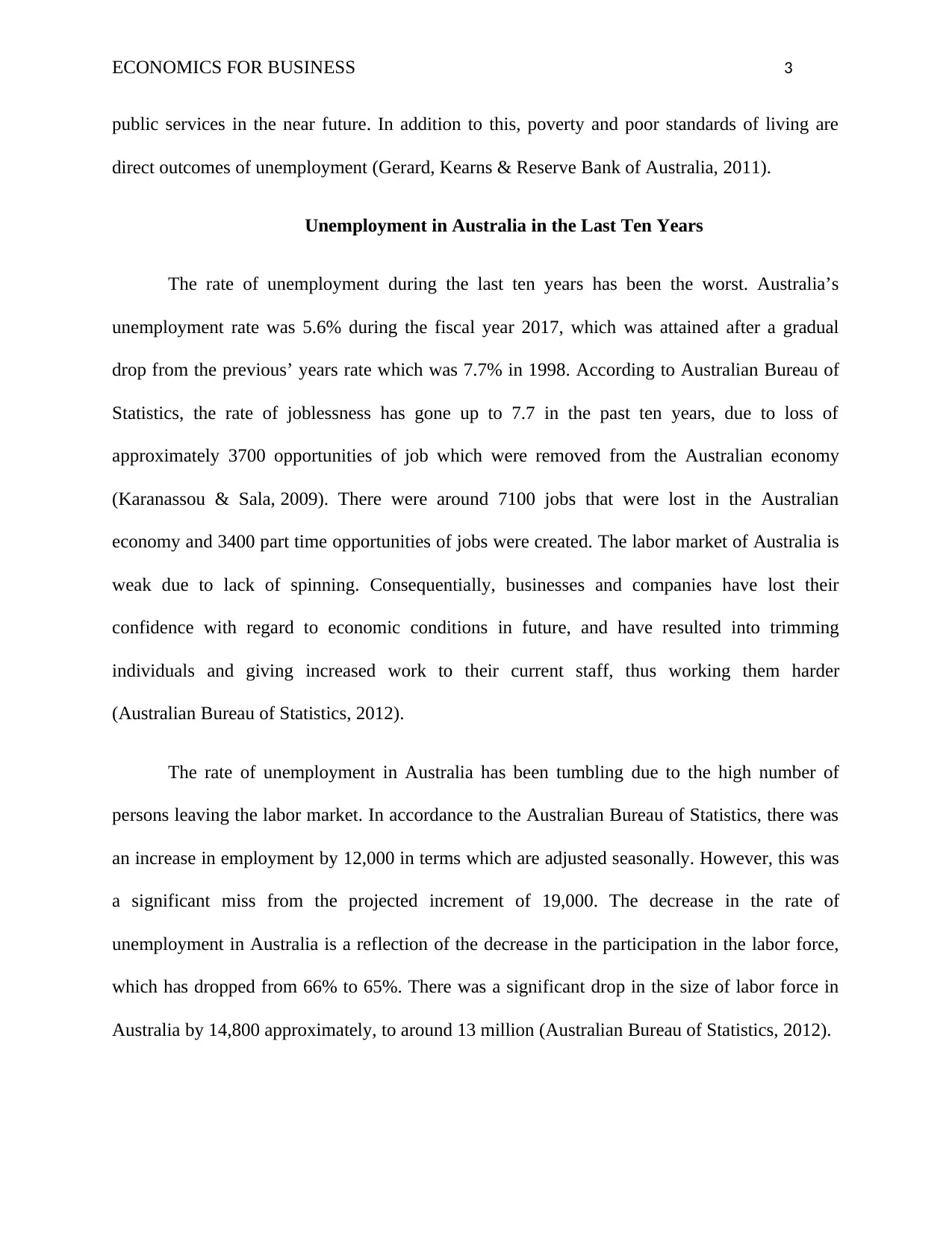
ECONOMICS FOR BUSINESS 3
public services in the near future. In addition to this, poverty and poor standards of living are
direct outcomes of unemployment (Gerard, Kearns & Reserve Bank of Australia, 2011).
Unemployment in Australia in the Last Ten Years
The rate of unemployment during the last ten years has been the worst. Australia’s
unemployment rate was 5.6% during the fiscal year 2017, which was attained after a gradual
drop from the previous’ years rate which was 7.7% in 1998. According to Australian Bureau of
Statistics, the rate of joblessness has gone up to 7.7 in the past ten years, due to loss of
approximately 3700 opportunities of job which were removed from the Australian economy
(Karanassou & Sala, 2009). There were around 7100 jobs that were lost in the Australian
economy and 3400 part time opportunities of jobs were created. The labor market of Australia is
weak due to lack of spinning. Consequentially, businesses and companies have lost their
confidence with regard to economic conditions in future, and have resulted into trimming
individuals and giving increased work to their current staff, thus working them harder
(Australian Bureau of Statistics, 2012).
The rate of unemployment in Australia has been tumbling due to the high number of
persons leaving the labor market. In accordance to the Australian Bureau of Statistics, there was
an increase in employment by 12,000 in terms which are adjusted seasonally. However, this was
a significant miss from the projected increment of 19,000. The decrease in the rate of
unemployment in Australia is a reflection of the decrease in the participation in the labor force,
which has dropped from 66% to 65%. There was a significant drop in the size of labor force in
Australia by 14,800 approximately, to around 13 million (Australian Bureau of Statistics, 2012).
public services in the near future. In addition to this, poverty and poor standards of living are
direct outcomes of unemployment (Gerard, Kearns & Reserve Bank of Australia, 2011).
Unemployment in Australia in the Last Ten Years
The rate of unemployment during the last ten years has been the worst. Australia’s
unemployment rate was 5.6% during the fiscal year 2017, which was attained after a gradual
drop from the previous’ years rate which was 7.7% in 1998. According to Australian Bureau of
Statistics, the rate of joblessness has gone up to 7.7 in the past ten years, due to loss of
approximately 3700 opportunities of job which were removed from the Australian economy
(Karanassou & Sala, 2009). There were around 7100 jobs that were lost in the Australian
economy and 3400 part time opportunities of jobs were created. The labor market of Australia is
weak due to lack of spinning. Consequentially, businesses and companies have lost their
confidence with regard to economic conditions in future, and have resulted into trimming
individuals and giving increased work to their current staff, thus working them harder
(Australian Bureau of Statistics, 2012).
The rate of unemployment in Australia has been tumbling due to the high number of
persons leaving the labor market. In accordance to the Australian Bureau of Statistics, there was
an increase in employment by 12,000 in terms which are adjusted seasonally. However, this was
a significant miss from the projected increment of 19,000. The decrease in the rate of
unemployment in Australia is a reflection of the decrease in the participation in the labor force,
which has dropped from 66% to 65%. There was a significant drop in the size of labor force in
Australia by 14,800 approximately, to around 13 million (Australian Bureau of Statistics, 2012).
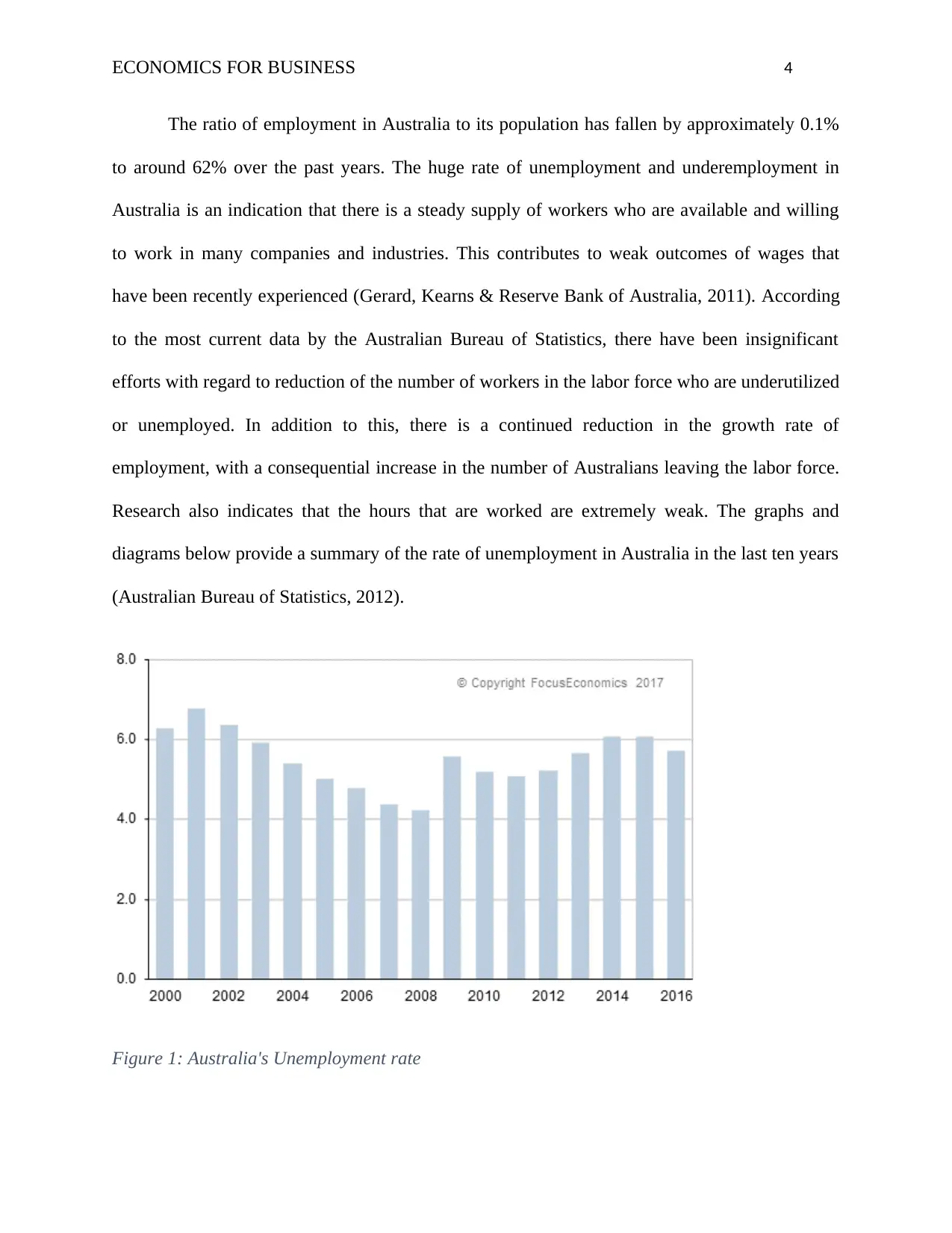
ECONOMICS FOR BUSINESS 4
The ratio of employment in Australia to its population has fallen by approximately 0.1%
to around 62% over the past years. The huge rate of unemployment and underemployment in
Australia is an indication that there is a steady supply of workers who are available and willing
to work in many companies and industries. This contributes to weak outcomes of wages that
have been recently experienced (Gerard, Kearns & Reserve Bank of Australia, 2011). According
to the most current data by the Australian Bureau of Statistics, there have been insignificant
efforts with regard to reduction of the number of workers in the labor force who are underutilized
or unemployed. In addition to this, there is a continued reduction in the growth rate of
employment, with a consequential increase in the number of Australians leaving the labor force.
Research also indicates that the hours that are worked are extremely weak. The graphs and
diagrams below provide a summary of the rate of unemployment in Australia in the last ten years
(Australian Bureau of Statistics, 2012).
Figure 1: Australia's Unemployment rate
The ratio of employment in Australia to its population has fallen by approximately 0.1%
to around 62% over the past years. The huge rate of unemployment and underemployment in
Australia is an indication that there is a steady supply of workers who are available and willing
to work in many companies and industries. This contributes to weak outcomes of wages that
have been recently experienced (Gerard, Kearns & Reserve Bank of Australia, 2011). According
to the most current data by the Australian Bureau of Statistics, there have been insignificant
efforts with regard to reduction of the number of workers in the labor force who are underutilized
or unemployed. In addition to this, there is a continued reduction in the growth rate of
employment, with a consequential increase in the number of Australians leaving the labor force.
Research also indicates that the hours that are worked are extremely weak. The graphs and
diagrams below provide a summary of the rate of unemployment in Australia in the last ten years
(Australian Bureau of Statistics, 2012).
Figure 1: Australia's Unemployment rate
Secure Best Marks with AI Grader
Need help grading? Try our AI Grader for instant feedback on your assignments.
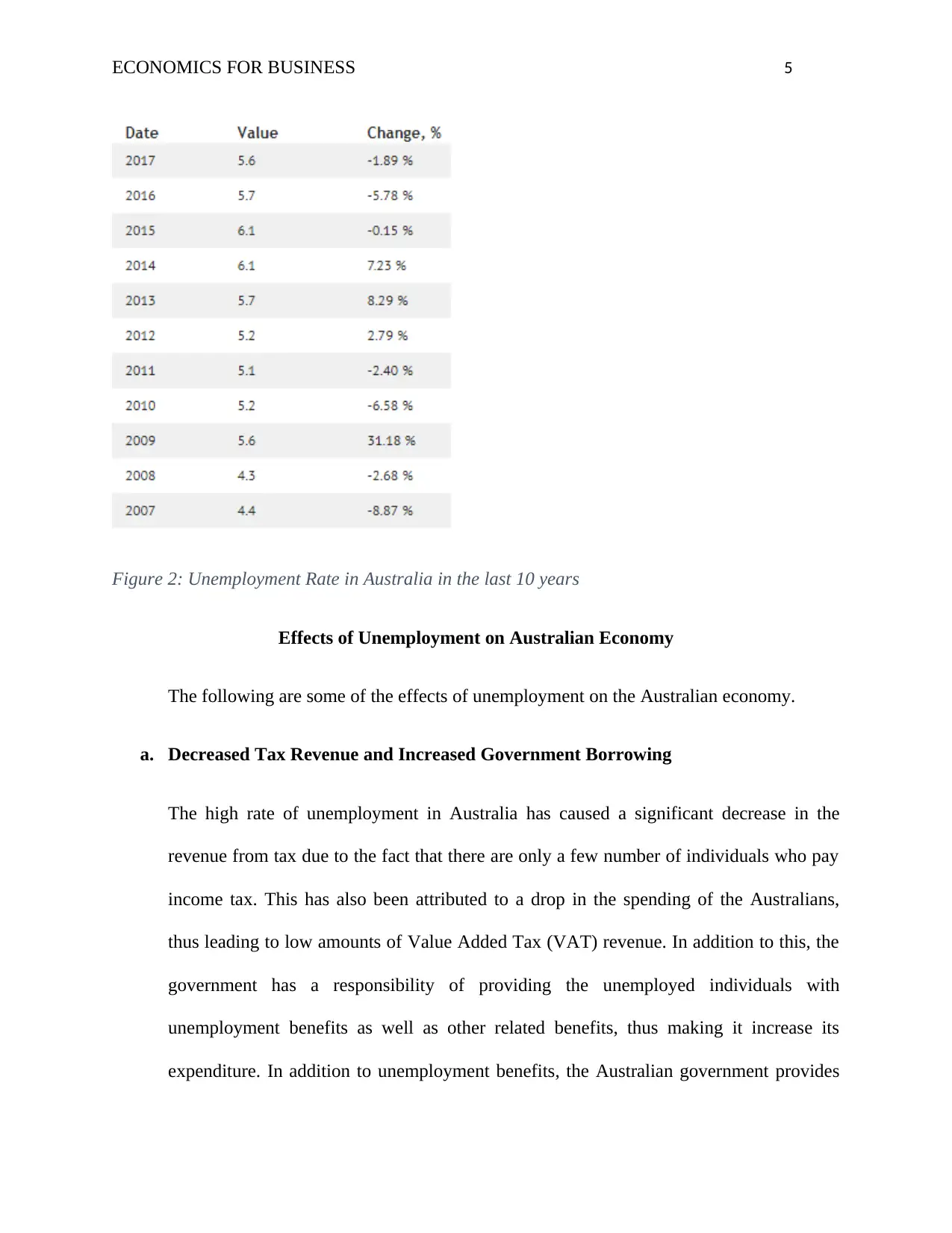
ECONOMICS FOR BUSINESS 5
Figure 2: Unemployment Rate in Australia in the last 10 years
Effects of Unemployment on Australian Economy
The following are some of the effects of unemployment on the Australian economy.
a. Decreased Tax Revenue and Increased Government Borrowing
The high rate of unemployment in Australia has caused a significant decrease in the
revenue from tax due to the fact that there are only a few number of individuals who pay
income tax. This has also been attributed to a drop in the spending of the Australians,
thus leading to low amounts of Value Added Tax (VAT) revenue. In addition to this, the
government has a responsibility of providing the unemployed individuals with
unemployment benefits as well as other related benefits, thus making it increase its
expenditure. In addition to unemployment benefits, the Australian government provides
Figure 2: Unemployment Rate in Australia in the last 10 years
Effects of Unemployment on Australian Economy
The following are some of the effects of unemployment on the Australian economy.
a. Decreased Tax Revenue and Increased Government Borrowing
The high rate of unemployment in Australia has caused a significant decrease in the
revenue from tax due to the fact that there are only a few number of individuals who pay
income tax. This has also been attributed to a drop in the spending of the Australians,
thus leading to low amounts of Value Added Tax (VAT) revenue. In addition to this, the
government has a responsibility of providing the unemployed individuals with
unemployment benefits as well as other related benefits, thus making it increase its
expenditure. In addition to unemployment benefits, the Australian government provides
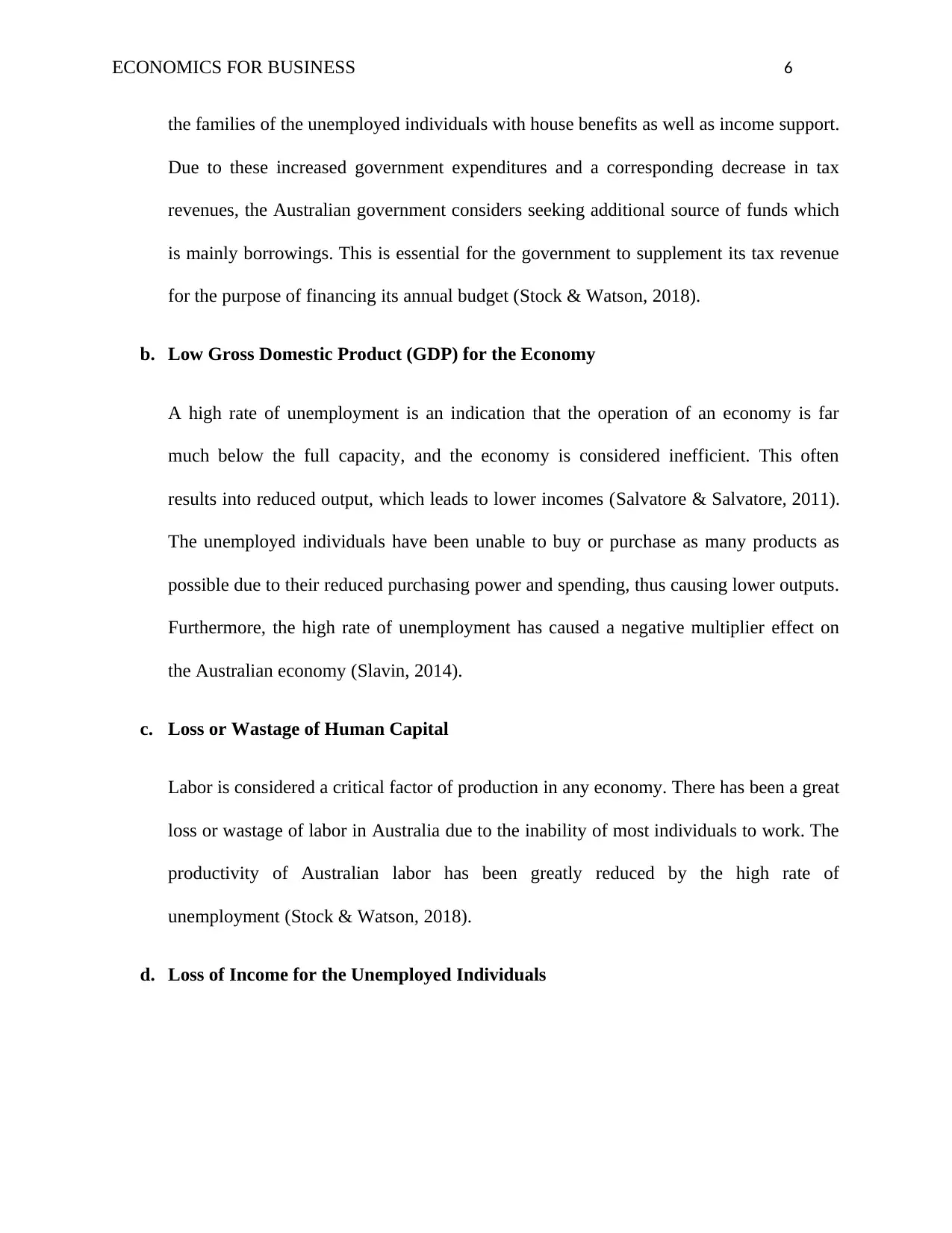
ECONOMICS FOR BUSINESS 6
the families of the unemployed individuals with house benefits as well as income support.
Due to these increased government expenditures and a corresponding decrease in tax
revenues, the Australian government considers seeking additional source of funds which
is mainly borrowings. This is essential for the government to supplement its tax revenue
for the purpose of financing its annual budget (Stock & Watson, 2018).
b. Low Gross Domestic Product (GDP) for the Economy
A high rate of unemployment is an indication that the operation of an economy is far
much below the full capacity, and the economy is considered inefficient. This often
results into reduced output, which leads to lower incomes (Salvatore & Salvatore, 2011).
The unemployed individuals have been unable to buy or purchase as many products as
possible due to their reduced purchasing power and spending, thus causing lower outputs.
Furthermore, the high rate of unemployment has caused a negative multiplier effect on
the Australian economy (Slavin, 2014).
c. Loss or Wastage of Human Capital
Labor is considered a critical factor of production in any economy. There has been a great
loss or wastage of labor in Australia due to the inability of most individuals to work. The
productivity of Australian labor has been greatly reduced by the high rate of
unemployment (Stock & Watson, 2018).
d. Loss of Income for the Unemployed Individuals
the families of the unemployed individuals with house benefits as well as income support.
Due to these increased government expenditures and a corresponding decrease in tax
revenues, the Australian government considers seeking additional source of funds which
is mainly borrowings. This is essential for the government to supplement its tax revenue
for the purpose of financing its annual budget (Stock & Watson, 2018).
b. Low Gross Domestic Product (GDP) for the Economy
A high rate of unemployment is an indication that the operation of an economy is far
much below the full capacity, and the economy is considered inefficient. This often
results into reduced output, which leads to lower incomes (Salvatore & Salvatore, 2011).
The unemployed individuals have been unable to buy or purchase as many products as
possible due to their reduced purchasing power and spending, thus causing lower outputs.
Furthermore, the high rate of unemployment has caused a negative multiplier effect on
the Australian economy (Slavin, 2014).
c. Loss or Wastage of Human Capital
Labor is considered a critical factor of production in any economy. There has been a great
loss or wastage of labor in Australia due to the inability of most individuals to work. The
productivity of Australian labor has been greatly reduced by the high rate of
unemployment (Stock & Watson, 2018).
d. Loss of Income for the Unemployed Individuals
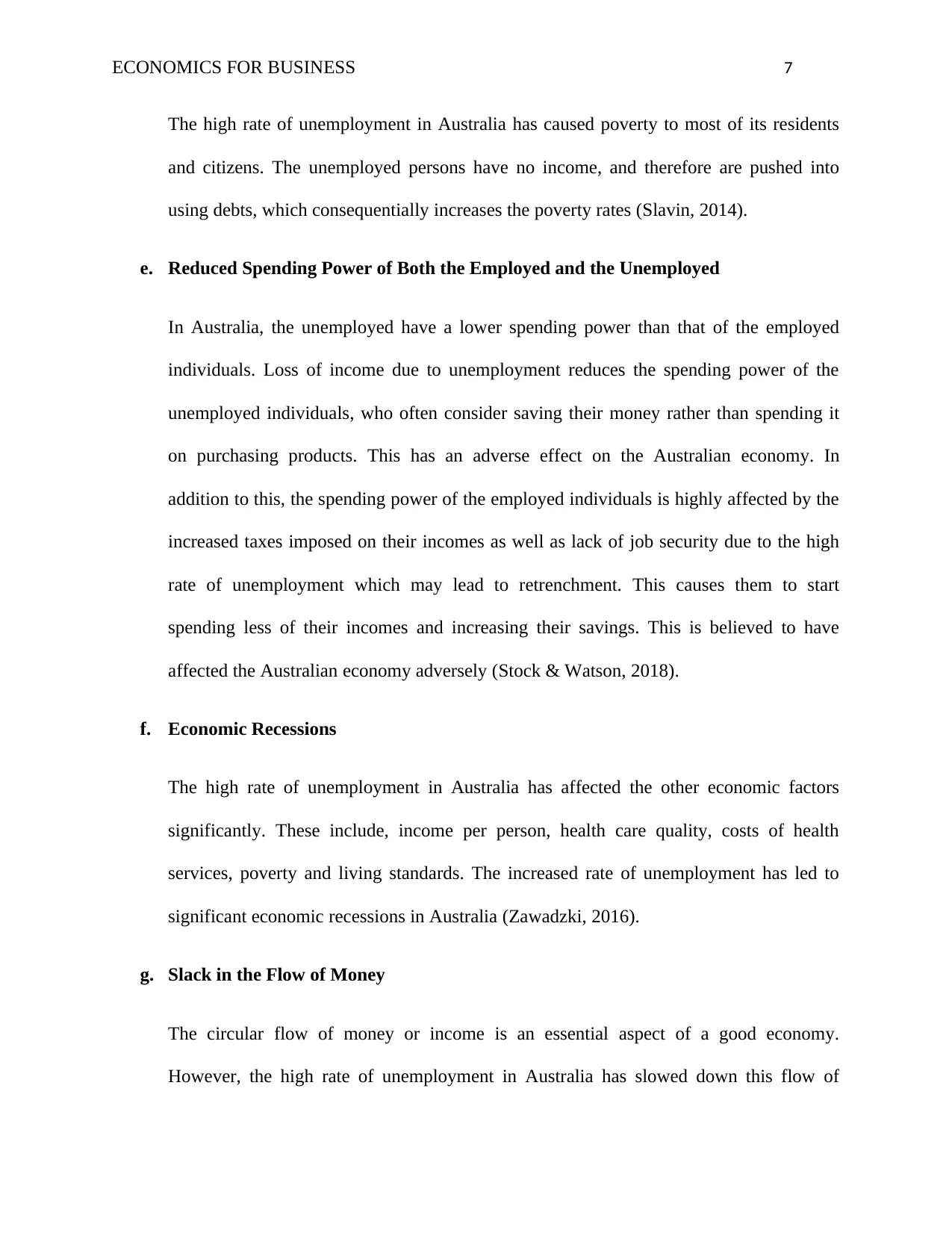
ECONOMICS FOR BUSINESS 7
The high rate of unemployment in Australia has caused poverty to most of its residents
and citizens. The unemployed persons have no income, and therefore are pushed into
using debts, which consequentially increases the poverty rates (Slavin, 2014).
e. Reduced Spending Power of Both the Employed and the Unemployed
In Australia, the unemployed have a lower spending power than that of the employed
individuals. Loss of income due to unemployment reduces the spending power of the
unemployed individuals, who often consider saving their money rather than spending it
on purchasing products. This has an adverse effect on the Australian economy. In
addition to this, the spending power of the employed individuals is highly affected by the
increased taxes imposed on their incomes as well as lack of job security due to the high
rate of unemployment which may lead to retrenchment. This causes them to start
spending less of their incomes and increasing their savings. This is believed to have
affected the Australian economy adversely (Stock & Watson, 2018).
f. Economic Recessions
The high rate of unemployment in Australia has affected the other economic factors
significantly. These include, income per person, health care quality, costs of health
services, poverty and living standards. The increased rate of unemployment has led to
significant economic recessions in Australia (Zawadzki, 2016).
g. Slack in the Flow of Money
The circular flow of money or income is an essential aspect of a good economy.
However, the high rate of unemployment in Australia has slowed down this flow of
The high rate of unemployment in Australia has caused poverty to most of its residents
and citizens. The unemployed persons have no income, and therefore are pushed into
using debts, which consequentially increases the poverty rates (Slavin, 2014).
e. Reduced Spending Power of Both the Employed and the Unemployed
In Australia, the unemployed have a lower spending power than that of the employed
individuals. Loss of income due to unemployment reduces the spending power of the
unemployed individuals, who often consider saving their money rather than spending it
on purchasing products. This has an adverse effect on the Australian economy. In
addition to this, the spending power of the employed individuals is highly affected by the
increased taxes imposed on their incomes as well as lack of job security due to the high
rate of unemployment which may lead to retrenchment. This causes them to start
spending less of their incomes and increasing their savings. This is believed to have
affected the Australian economy adversely (Stock & Watson, 2018).
f. Economic Recessions
The high rate of unemployment in Australia has affected the other economic factors
significantly. These include, income per person, health care quality, costs of health
services, poverty and living standards. The increased rate of unemployment has led to
significant economic recessions in Australia (Zawadzki, 2016).
g. Slack in the Flow of Money
The circular flow of money or income is an essential aspect of a good economy.
However, the high rate of unemployment in Australia has slowed down this flow of
Paraphrase This Document
Need a fresh take? Get an instant paraphrase of this document with our AI Paraphraser
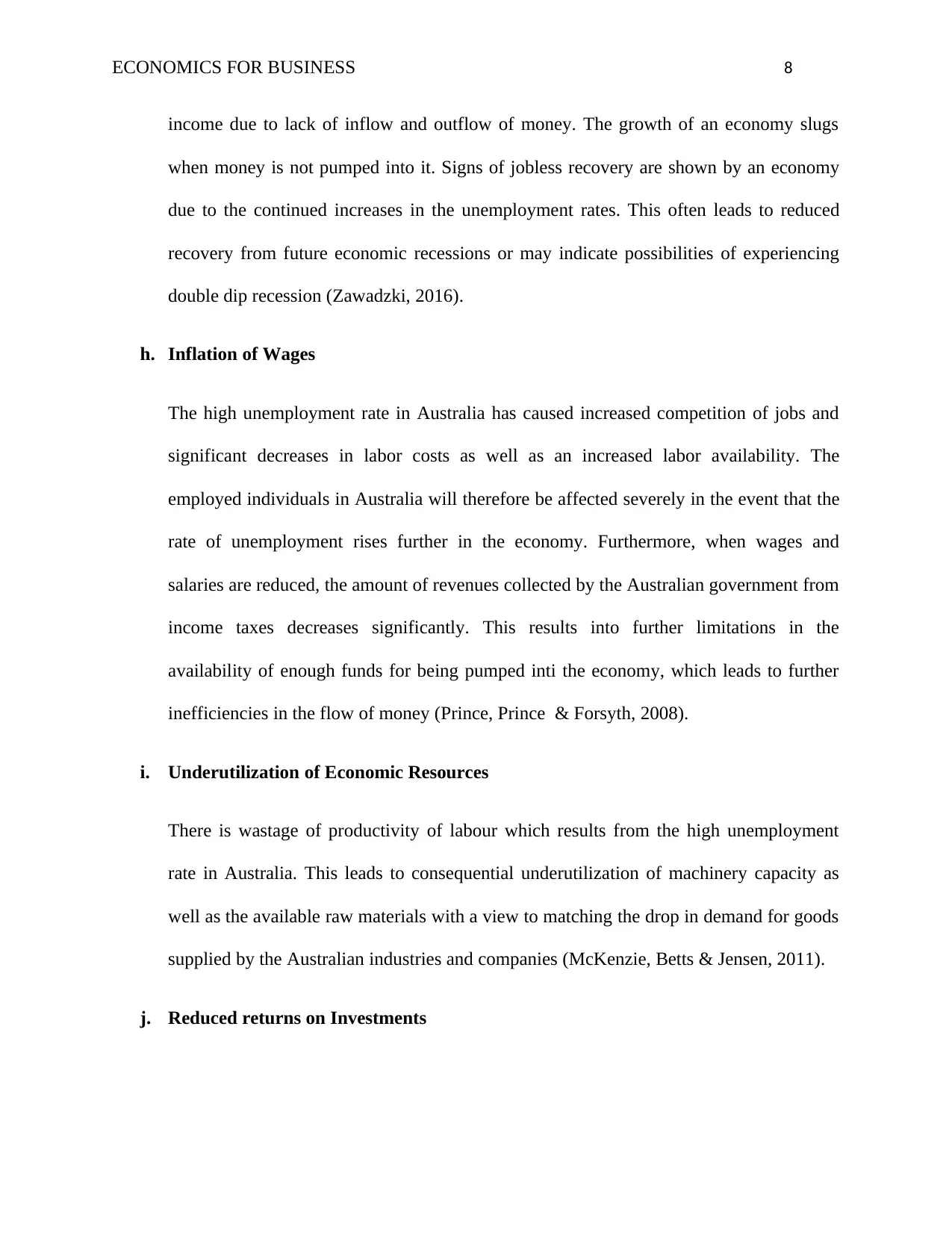
ECONOMICS FOR BUSINESS 8
income due to lack of inflow and outflow of money. The growth of an economy slugs
when money is not pumped into it. Signs of jobless recovery are shown by an economy
due to the continued increases in the unemployment rates. This often leads to reduced
recovery from future economic recessions or may indicate possibilities of experiencing
double dip recession (Zawadzki, 2016).
h. Inflation of Wages
The high unemployment rate in Australia has caused increased competition of jobs and
significant decreases in labor costs as well as an increased labor availability. The
employed individuals in Australia will therefore be affected severely in the event that the
rate of unemployment rises further in the economy. Furthermore, when wages and
salaries are reduced, the amount of revenues collected by the Australian government from
income taxes decreases significantly. This results into further limitations in the
availability of enough funds for being pumped inti the economy, which leads to further
inefficiencies in the flow of money (Prince, Prince & Forsyth, 2008).
i. Underutilization of Economic Resources
There is wastage of productivity of labour which results from the high unemployment
rate in Australia. This leads to consequential underutilization of machinery capacity as
well as the available raw materials with a view to matching the drop in demand for goods
supplied by the Australian industries and companies (McKenzie, Betts & Jensen, 2011).
j. Reduced returns on Investments
income due to lack of inflow and outflow of money. The growth of an economy slugs
when money is not pumped into it. Signs of jobless recovery are shown by an economy
due to the continued increases in the unemployment rates. This often leads to reduced
recovery from future economic recessions or may indicate possibilities of experiencing
double dip recession (Zawadzki, 2016).
h. Inflation of Wages
The high unemployment rate in Australia has caused increased competition of jobs and
significant decreases in labor costs as well as an increased labor availability. The
employed individuals in Australia will therefore be affected severely in the event that the
rate of unemployment rises further in the economy. Furthermore, when wages and
salaries are reduced, the amount of revenues collected by the Australian government from
income taxes decreases significantly. This results into further limitations in the
availability of enough funds for being pumped inti the economy, which leads to further
inefficiencies in the flow of money (Prince, Prince & Forsyth, 2008).
i. Underutilization of Economic Resources
There is wastage of productivity of labour which results from the high unemployment
rate in Australia. This leads to consequential underutilization of machinery capacity as
well as the available raw materials with a view to matching the drop in demand for goods
supplied by the Australian industries and companies (McKenzie, Betts & Jensen, 2011).
j. Reduced returns on Investments
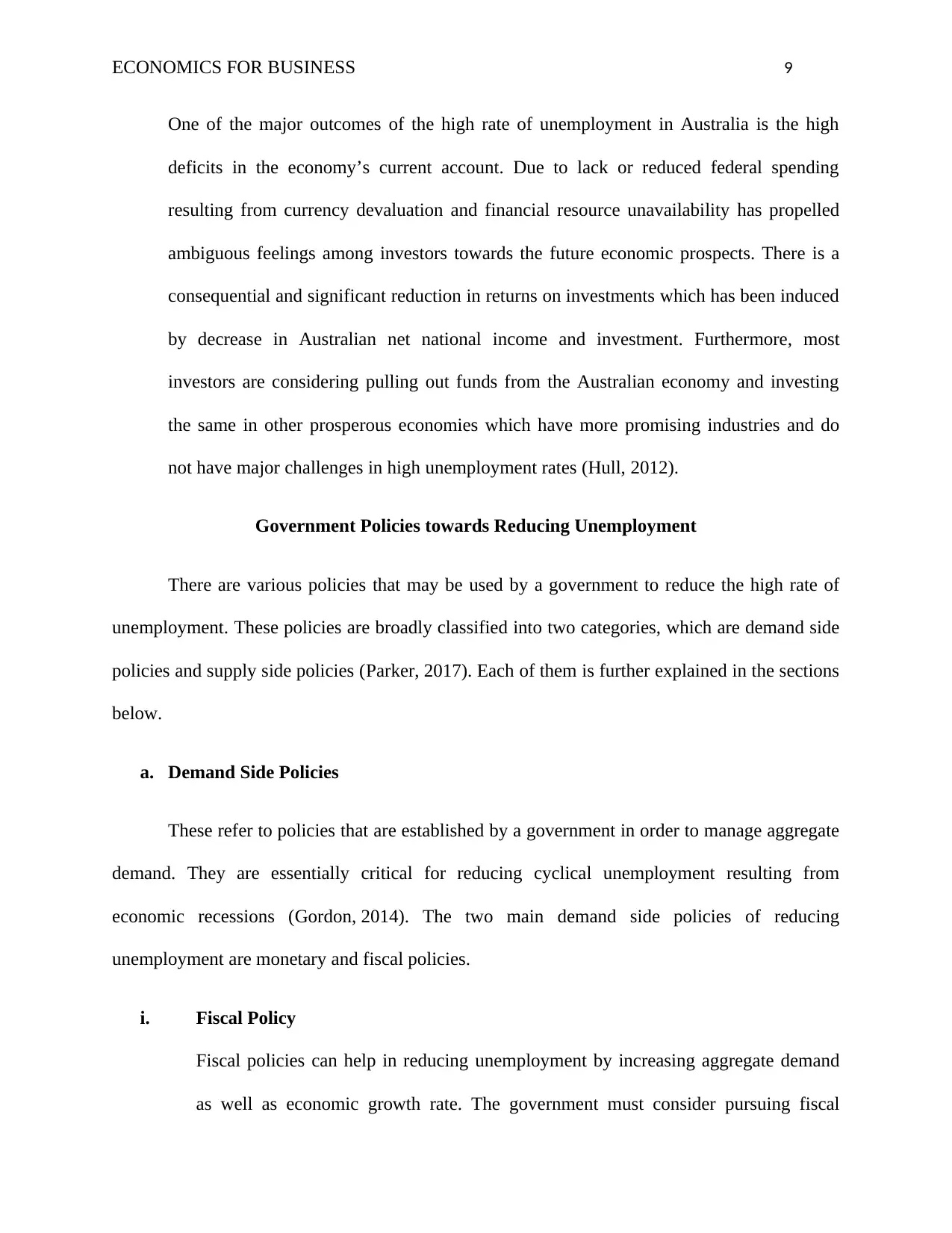
ECONOMICS FOR BUSINESS 9
One of the major outcomes of the high rate of unemployment in Australia is the high
deficits in the economy’s current account. Due to lack or reduced federal spending
resulting from currency devaluation and financial resource unavailability has propelled
ambiguous feelings among investors towards the future economic prospects. There is a
consequential and significant reduction in returns on investments which has been induced
by decrease in Australian net national income and investment. Furthermore, most
investors are considering pulling out funds from the Australian economy and investing
the same in other prosperous economies which have more promising industries and do
not have major challenges in high unemployment rates (Hull, 2012).
Government Policies towards Reducing Unemployment
There are various policies that may be used by a government to reduce the high rate of
unemployment. These policies are broadly classified into two categories, which are demand side
policies and supply side policies (Parker, 2017). Each of them is further explained in the sections
below.
a. Demand Side Policies
These refer to policies that are established by a government in order to manage aggregate
demand. They are essentially critical for reducing cyclical unemployment resulting from
economic recessions (Gordon, 2014). The two main demand side policies of reducing
unemployment are monetary and fiscal policies.
i. Fiscal Policy
Fiscal policies can help in reducing unemployment by increasing aggregate demand
as well as economic growth rate. The government must consider pursuing fiscal
One of the major outcomes of the high rate of unemployment in Australia is the high
deficits in the economy’s current account. Due to lack or reduced federal spending
resulting from currency devaluation and financial resource unavailability has propelled
ambiguous feelings among investors towards the future economic prospects. There is a
consequential and significant reduction in returns on investments which has been induced
by decrease in Australian net national income and investment. Furthermore, most
investors are considering pulling out funds from the Australian economy and investing
the same in other prosperous economies which have more promising industries and do
not have major challenges in high unemployment rates (Hull, 2012).
Government Policies towards Reducing Unemployment
There are various policies that may be used by a government to reduce the high rate of
unemployment. These policies are broadly classified into two categories, which are demand side
policies and supply side policies (Parker, 2017). Each of them is further explained in the sections
below.
a. Demand Side Policies
These refer to policies that are established by a government in order to manage aggregate
demand. They are essentially critical for reducing cyclical unemployment resulting from
economic recessions (Gordon, 2014). The two main demand side policies of reducing
unemployment are monetary and fiscal policies.
i. Fiscal Policy
Fiscal policies can help in reducing unemployment by increasing aggregate demand
as well as economic growth rate. The government must consider pursuing fiscal
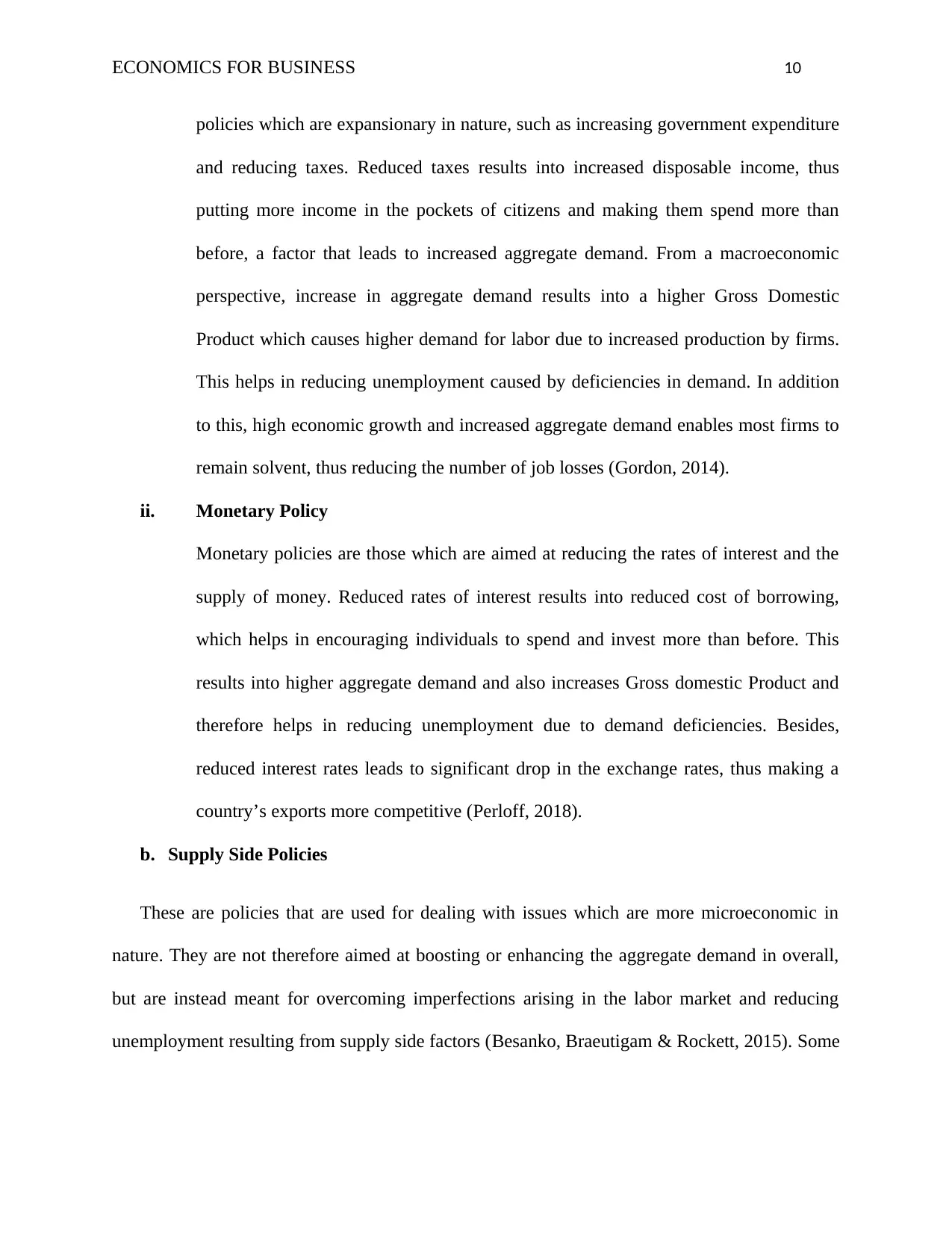
ECONOMICS FOR BUSINESS 10
policies which are expansionary in nature, such as increasing government expenditure
and reducing taxes. Reduced taxes results into increased disposable income, thus
putting more income in the pockets of citizens and making them spend more than
before, a factor that leads to increased aggregate demand. From a macroeconomic
perspective, increase in aggregate demand results into a higher Gross Domestic
Product which causes higher demand for labor due to increased production by firms.
This helps in reducing unemployment caused by deficiencies in demand. In addition
to this, high economic growth and increased aggregate demand enables most firms to
remain solvent, thus reducing the number of job losses (Gordon, 2014).
ii. Monetary Policy
Monetary policies are those which are aimed at reducing the rates of interest and the
supply of money. Reduced rates of interest results into reduced cost of borrowing,
which helps in encouraging individuals to spend and invest more than before. This
results into higher aggregate demand and also increases Gross domestic Product and
therefore helps in reducing unemployment due to demand deficiencies. Besides,
reduced interest rates leads to significant drop in the exchange rates, thus making a
country’s exports more competitive (Perloff, 2018).
b. Supply Side Policies
These are policies that are used for dealing with issues which are more microeconomic in
nature. They are not therefore aimed at boosting or enhancing the aggregate demand in overall,
but are instead meant for overcoming imperfections arising in the labor market and reducing
unemployment resulting from supply side factors (Besanko, Braeutigam & Rockett, 2015). Some
policies which are expansionary in nature, such as increasing government expenditure
and reducing taxes. Reduced taxes results into increased disposable income, thus
putting more income in the pockets of citizens and making them spend more than
before, a factor that leads to increased aggregate demand. From a macroeconomic
perspective, increase in aggregate demand results into a higher Gross Domestic
Product which causes higher demand for labor due to increased production by firms.
This helps in reducing unemployment caused by deficiencies in demand. In addition
to this, high economic growth and increased aggregate demand enables most firms to
remain solvent, thus reducing the number of job losses (Gordon, 2014).
ii. Monetary Policy
Monetary policies are those which are aimed at reducing the rates of interest and the
supply of money. Reduced rates of interest results into reduced cost of borrowing,
which helps in encouraging individuals to spend and invest more than before. This
results into higher aggregate demand and also increases Gross domestic Product and
therefore helps in reducing unemployment due to demand deficiencies. Besides,
reduced interest rates leads to significant drop in the exchange rates, thus making a
country’s exports more competitive (Perloff, 2018).
b. Supply Side Policies
These are policies that are used for dealing with issues which are more microeconomic in
nature. They are not therefore aimed at boosting or enhancing the aggregate demand in overall,
but are instead meant for overcoming imperfections arising in the labor market and reducing
unemployment resulting from supply side factors (Besanko, Braeutigam & Rockett, 2015). Some
Secure Best Marks with AI Grader
Need help grading? Try our AI Grader for instant feedback on your assignments.

ECONOMICS FOR BUSINESS 11
of the supply side policies that can be used to reduce the rate of unemployment are discussed
below.
i. Education and Training
This aims primarily at providing those individuals who are long-term employed with
new skills and expertise for enabling them look for jobs within the developing
industries. For instance, the government may consider retraining the unemployed
workers in the steel sector in order to equip them with basic computer and
Information Technology skills which may assist them in finding work in other service
sectors (Newbold, Carlson & Thorne, 2013).
ii. Reducing the Power of Trade Unions
Real wage unemployment may be potentially caused by the bargaining power of
unions for setting wages far much above the market rate or level. Therefore, the
government can reduce this type of unemployment through reduction of trade unions’
influence or alternatively setting minimum wages at a lower level (Marshall, 2013).
iii. Subsidies of Employment
The government can significantly reduce unemployment by issuing subsidies or tax
breaks to firms if they seek to employ or take the long term unemployed individuals.
However, the government must exercise this with much care since firma may
consider replacing their current staff with the long term unemployed persons with a
view to benefiting from the subsidies and tax breaks (Haugen & Musser, 2011).
iv. Improving the Flexibility of the Labor Markets
The high rate of structural unemployment in Australia is highly attributed to
restrictive labor markets which are not flexible enough to encourage firms to employ
of the supply side policies that can be used to reduce the rate of unemployment are discussed
below.
i. Education and Training
This aims primarily at providing those individuals who are long-term employed with
new skills and expertise for enabling them look for jobs within the developing
industries. For instance, the government may consider retraining the unemployed
workers in the steel sector in order to equip them with basic computer and
Information Technology skills which may assist them in finding work in other service
sectors (Newbold, Carlson & Thorne, 2013).
ii. Reducing the Power of Trade Unions
Real wage unemployment may be potentially caused by the bargaining power of
unions for setting wages far much above the market rate or level. Therefore, the
government can reduce this type of unemployment through reduction of trade unions’
influence or alternatively setting minimum wages at a lower level (Marshall, 2013).
iii. Subsidies of Employment
The government can significantly reduce unemployment by issuing subsidies or tax
breaks to firms if they seek to employ or take the long term unemployed individuals.
However, the government must exercise this with much care since firma may
consider replacing their current staff with the long term unemployed persons with a
view to benefiting from the subsidies and tax breaks (Haugen & Musser, 2011).
iv. Improving the Flexibility of the Labor Markets
The high rate of structural unemployment in Australia is highly attributed to
restrictive labor markets which are not flexible enough to encourage firms to employ
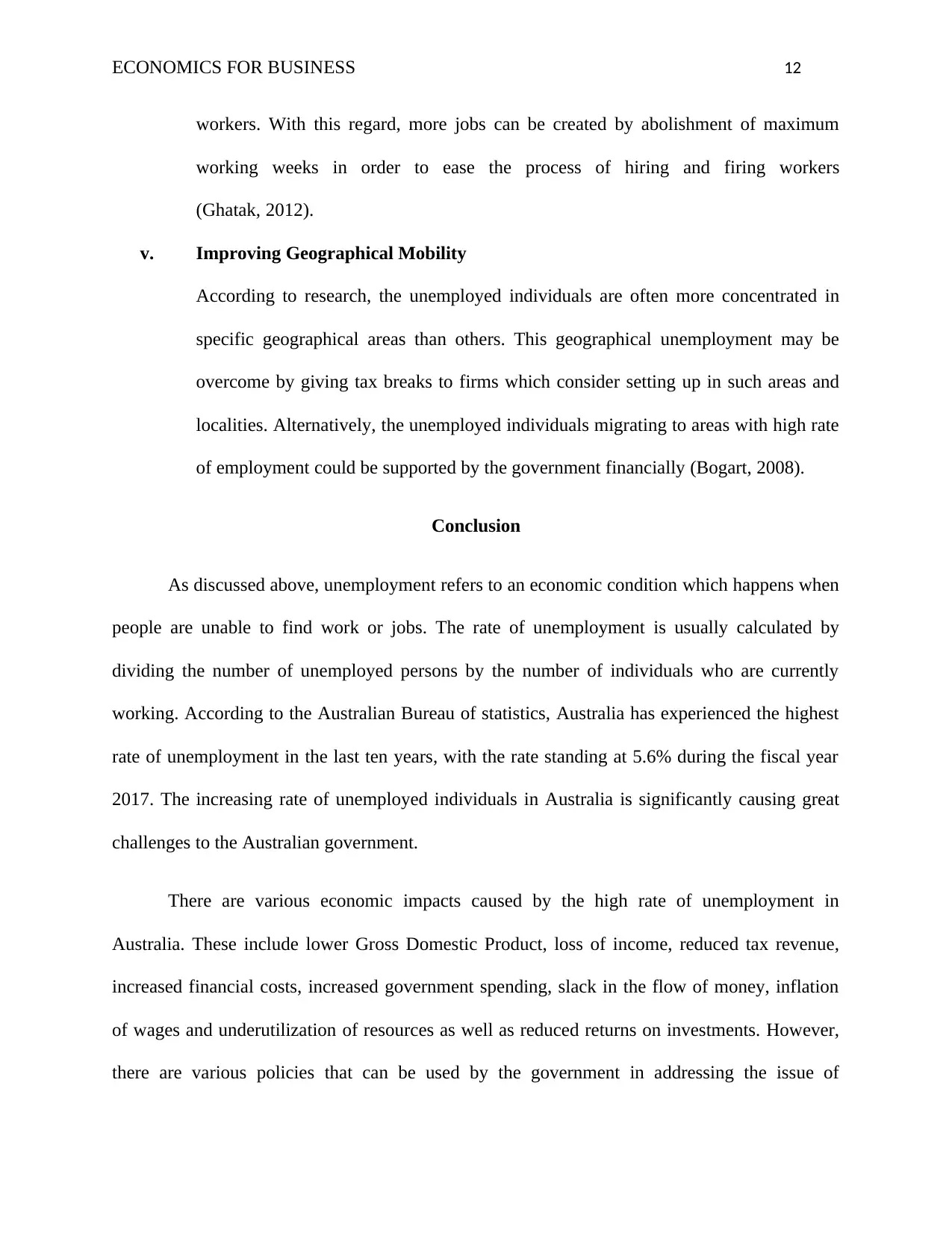
ECONOMICS FOR BUSINESS 12
workers. With this regard, more jobs can be created by abolishment of maximum
working weeks in order to ease the process of hiring and firing workers
(Ghatak, 2012).
v. Improving Geographical Mobility
According to research, the unemployed individuals are often more concentrated in
specific geographical areas than others. This geographical unemployment may be
overcome by giving tax breaks to firms which consider setting up in such areas and
localities. Alternatively, the unemployed individuals migrating to areas with high rate
of employment could be supported by the government financially (Bogart, 2008).
Conclusion
As discussed above, unemployment refers to an economic condition which happens when
people are unable to find work or jobs. The rate of unemployment is usually calculated by
dividing the number of unemployed persons by the number of individuals who are currently
working. According to the Australian Bureau of statistics, Australia has experienced the highest
rate of unemployment in the last ten years, with the rate standing at 5.6% during the fiscal year
2017. The increasing rate of unemployed individuals in Australia is significantly causing great
challenges to the Australian government.
There are various economic impacts caused by the high rate of unemployment in
Australia. These include lower Gross Domestic Product, loss of income, reduced tax revenue,
increased financial costs, increased government spending, slack in the flow of money, inflation
of wages and underutilization of resources as well as reduced returns on investments. However,
there are various policies that can be used by the government in addressing the issue of
workers. With this regard, more jobs can be created by abolishment of maximum
working weeks in order to ease the process of hiring and firing workers
(Ghatak, 2012).
v. Improving Geographical Mobility
According to research, the unemployed individuals are often more concentrated in
specific geographical areas than others. This geographical unemployment may be
overcome by giving tax breaks to firms which consider setting up in such areas and
localities. Alternatively, the unemployed individuals migrating to areas with high rate
of employment could be supported by the government financially (Bogart, 2008).
Conclusion
As discussed above, unemployment refers to an economic condition which happens when
people are unable to find work or jobs. The rate of unemployment is usually calculated by
dividing the number of unemployed persons by the number of individuals who are currently
working. According to the Australian Bureau of statistics, Australia has experienced the highest
rate of unemployment in the last ten years, with the rate standing at 5.6% during the fiscal year
2017. The increasing rate of unemployed individuals in Australia is significantly causing great
challenges to the Australian government.
There are various economic impacts caused by the high rate of unemployment in
Australia. These include lower Gross Domestic Product, loss of income, reduced tax revenue,
increased financial costs, increased government spending, slack in the flow of money, inflation
of wages and underutilization of resources as well as reduced returns on investments. However,
there are various policies that can be used by the government in addressing the issue of
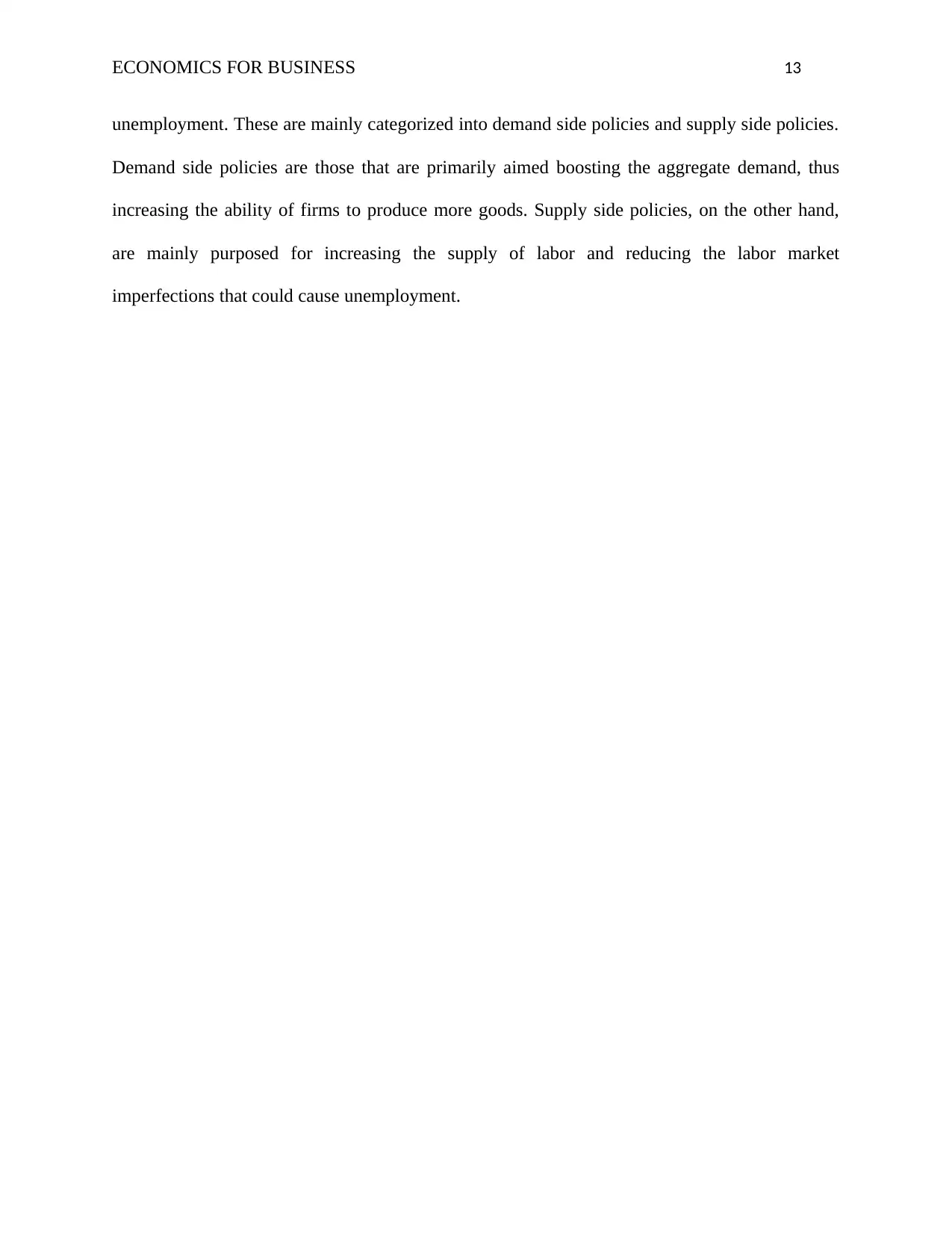
ECONOMICS FOR BUSINESS 13
unemployment. These are mainly categorized into demand side policies and supply side policies.
Demand side policies are those that are primarily aimed boosting the aggregate demand, thus
increasing the ability of firms to produce more goods. Supply side policies, on the other hand,
are mainly purposed for increasing the supply of labor and reducing the labor market
imperfections that could cause unemployment.
unemployment. These are mainly categorized into demand side policies and supply side policies.
Demand side policies are those that are primarily aimed boosting the aggregate demand, thus
increasing the ability of firms to produce more goods. Supply side policies, on the other hand,
are mainly purposed for increasing the supply of labor and reducing the labor market
imperfections that could cause unemployment.
Paraphrase This Document
Need a fresh take? Get an instant paraphrase of this document with our AI Paraphraser
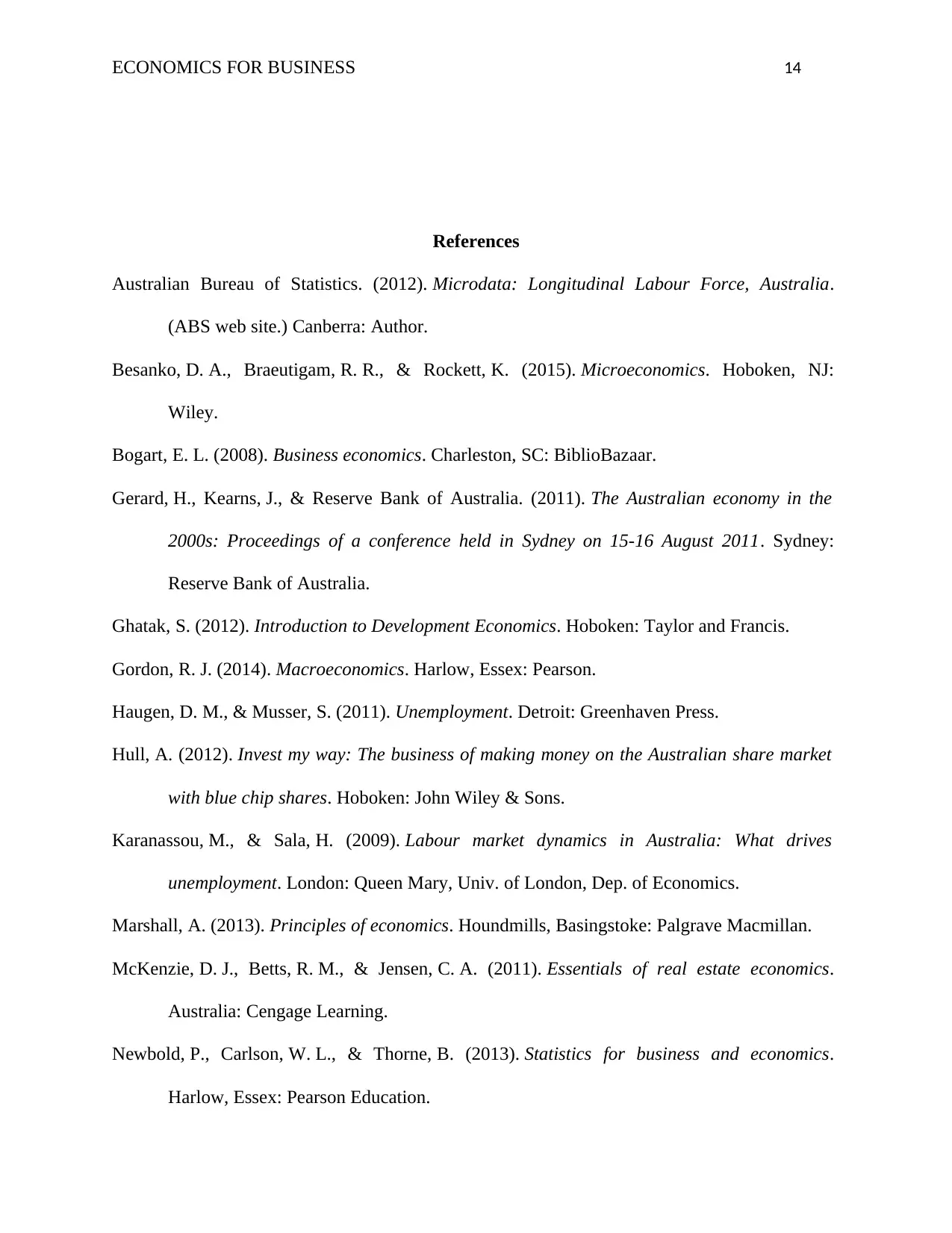
ECONOMICS FOR BUSINESS 14
References
Australian Bureau of Statistics. (2012). Microdata: Longitudinal Labour Force, Australia.
(ABS web site.) Canberra: Author.
Besanko, D. A., Braeutigam, R. R., & Rockett, K. (2015). Microeconomics. Hoboken, NJ:
Wiley.
Bogart, E. L. (2008). Business economics. Charleston, SC: BiblioBazaar.
Gerard, H., Kearns, J., & Reserve Bank of Australia. (2011). The Australian economy in the
2000s: Proceedings of a conference held in Sydney on 15-16 August 2011. Sydney:
Reserve Bank of Australia.
Ghatak, S. (2012). Introduction to Development Economics. Hoboken: Taylor and Francis.
Gordon, R. J. (2014). Macroeconomics. Harlow, Essex: Pearson.
Haugen, D. M., & Musser, S. (2011). Unemployment. Detroit: Greenhaven Press.
Hull, A. (2012). Invest my way: The business of making money on the Australian share market
with blue chip shares. Hoboken: John Wiley & Sons.
Karanassou, M., & Sala, H. (2009). Labour market dynamics in Australia: What drives
unemployment. London: Queen Mary, Univ. of London, Dep. of Economics.
Marshall, A. (2013). Principles of economics. Houndmills, Basingstoke: Palgrave Macmillan.
McKenzie, D. J., Betts, R. M., & Jensen, C. A. (2011). Essentials of real estate economics.
Australia: Cengage Learning.
Newbold, P., Carlson, W. L., & Thorne, B. (2013). Statistics for business and economics.
Harlow, Essex: Pearson Education.
References
Australian Bureau of Statistics. (2012). Microdata: Longitudinal Labour Force, Australia.
(ABS web site.) Canberra: Author.
Besanko, D. A., Braeutigam, R. R., & Rockett, K. (2015). Microeconomics. Hoboken, NJ:
Wiley.
Bogart, E. L. (2008). Business economics. Charleston, SC: BiblioBazaar.
Gerard, H., Kearns, J., & Reserve Bank of Australia. (2011). The Australian economy in the
2000s: Proceedings of a conference held in Sydney on 15-16 August 2011. Sydney:
Reserve Bank of Australia.
Ghatak, S. (2012). Introduction to Development Economics. Hoboken: Taylor and Francis.
Gordon, R. J. (2014). Macroeconomics. Harlow, Essex: Pearson.
Haugen, D. M., & Musser, S. (2011). Unemployment. Detroit: Greenhaven Press.
Hull, A. (2012). Invest my way: The business of making money on the Australian share market
with blue chip shares. Hoboken: John Wiley & Sons.
Karanassou, M., & Sala, H. (2009). Labour market dynamics in Australia: What drives
unemployment. London: Queen Mary, Univ. of London, Dep. of Economics.
Marshall, A. (2013). Principles of economics. Houndmills, Basingstoke: Palgrave Macmillan.
McKenzie, D. J., Betts, R. M., & Jensen, C. A. (2011). Essentials of real estate economics.
Australia: Cengage Learning.
Newbold, P., Carlson, W. L., & Thorne, B. (2013). Statistics for business and economics.
Harlow, Essex: Pearson Education.
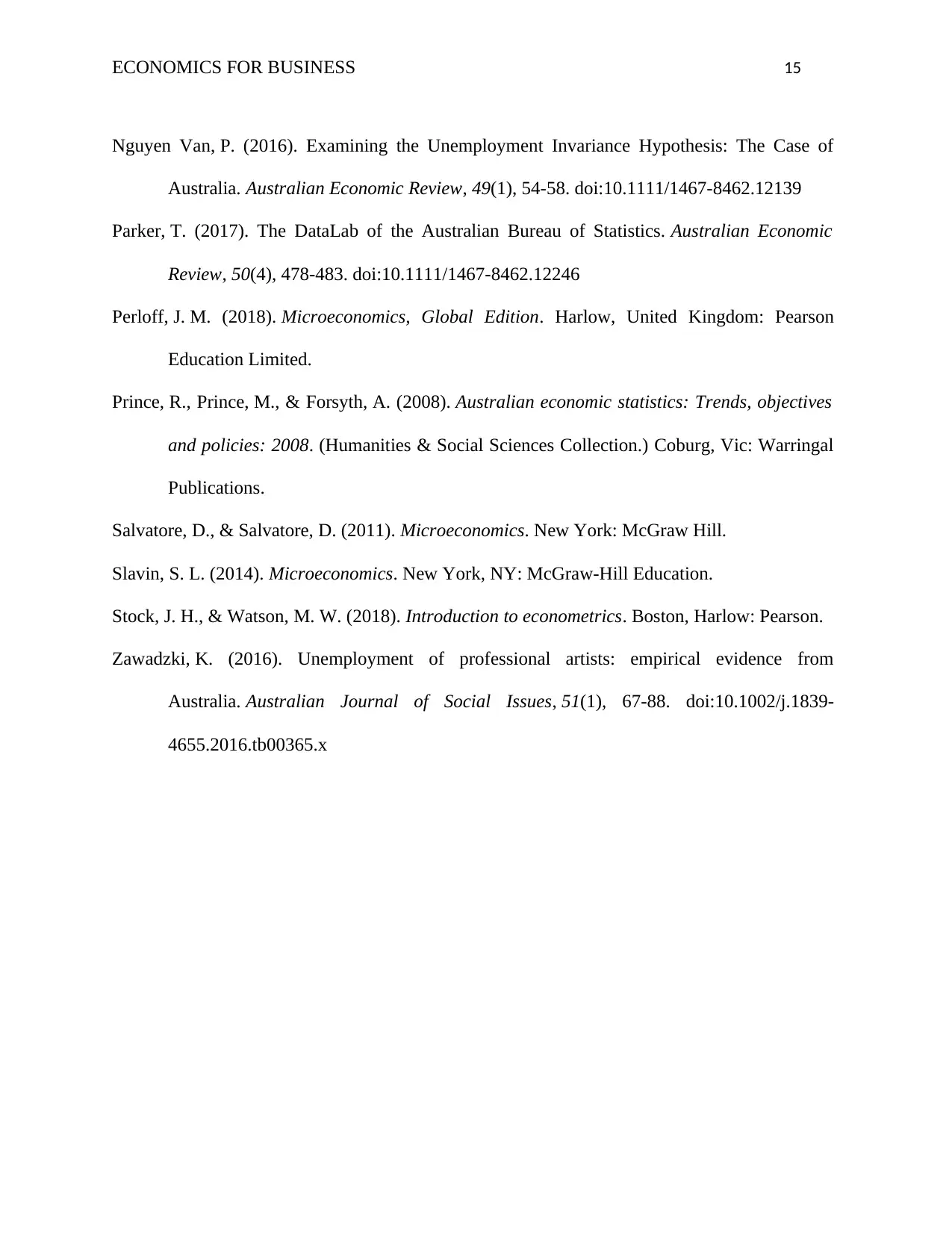
ECONOMICS FOR BUSINESS 15
Nguyen Van, P. (2016). Examining the Unemployment Invariance Hypothesis: The Case of
Australia. Australian Economic Review, 49(1), 54-58. doi:10.1111/1467-8462.12139
Parker, T. (2017). The DataLab of the Australian Bureau of Statistics. Australian Economic
Review, 50(4), 478-483. doi:10.1111/1467-8462.12246
Perloff, J. M. (2018). Microeconomics, Global Edition. Harlow, United Kingdom: Pearson
Education Limited.
Prince, R., Prince, M., & Forsyth, A. (2008). Australian economic statistics: Trends, objectives
and policies: 2008. (Humanities & Social Sciences Collection.) Coburg, Vic: Warringal
Publications.
Salvatore, D., & Salvatore, D. (2011). Microeconomics. New York: McGraw Hill.
Slavin, S. L. (2014). Microeconomics. New York, NY: McGraw-Hill Education.
Stock, J. H., & Watson, M. W. (2018). Introduction to econometrics. Boston, Harlow: Pearson.
Zawadzki, K. (2016). Unemployment of professional artists: empirical evidence from
Australia. Australian Journal of Social Issues, 51(1), 67-88. doi:10.1002/j.1839-
4655.2016.tb00365.x
Nguyen Van, P. (2016). Examining the Unemployment Invariance Hypothesis: The Case of
Australia. Australian Economic Review, 49(1), 54-58. doi:10.1111/1467-8462.12139
Parker, T. (2017). The DataLab of the Australian Bureau of Statistics. Australian Economic
Review, 50(4), 478-483. doi:10.1111/1467-8462.12246
Perloff, J. M. (2018). Microeconomics, Global Edition. Harlow, United Kingdom: Pearson
Education Limited.
Prince, R., Prince, M., & Forsyth, A. (2008). Australian economic statistics: Trends, objectives
and policies: 2008. (Humanities & Social Sciences Collection.) Coburg, Vic: Warringal
Publications.
Salvatore, D., & Salvatore, D. (2011). Microeconomics. New York: McGraw Hill.
Slavin, S. L. (2014). Microeconomics. New York, NY: McGraw-Hill Education.
Stock, J. H., & Watson, M. W. (2018). Introduction to econometrics. Boston, Harlow: Pearson.
Zawadzki, K. (2016). Unemployment of professional artists: empirical evidence from
Australia. Australian Journal of Social Issues, 51(1), 67-88. doi:10.1002/j.1839-
4655.2016.tb00365.x
1 out of 15
Related Documents
Your All-in-One AI-Powered Toolkit for Academic Success.
+13062052269
info@desklib.com
Available 24*7 on WhatsApp / Email
![[object Object]](/_next/static/media/star-bottom.7253800d.svg)
Unlock your academic potential
© 2024 | Zucol Services PVT LTD | All rights reserved.



